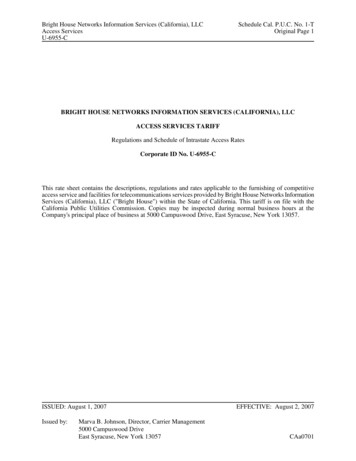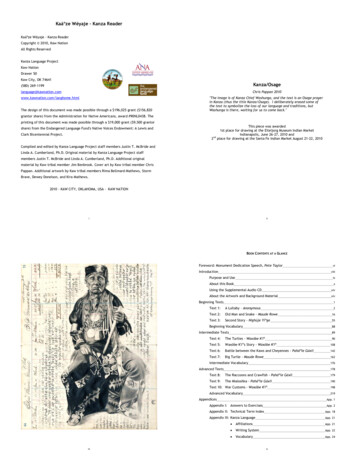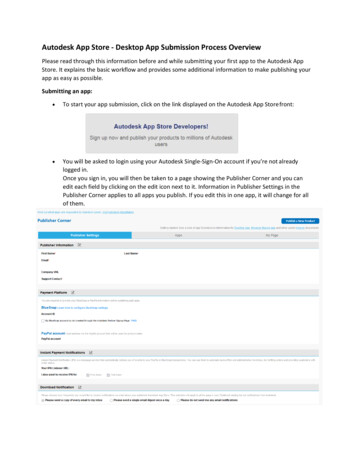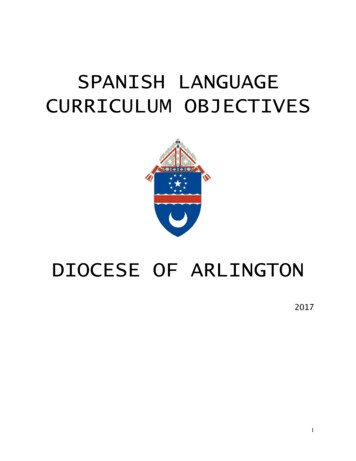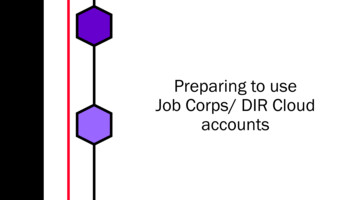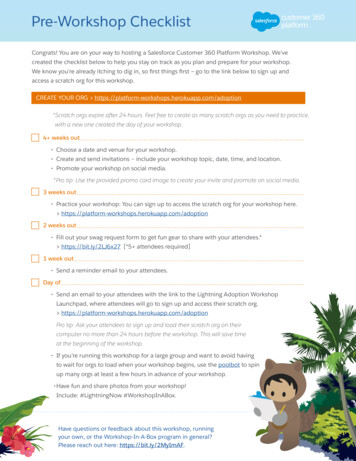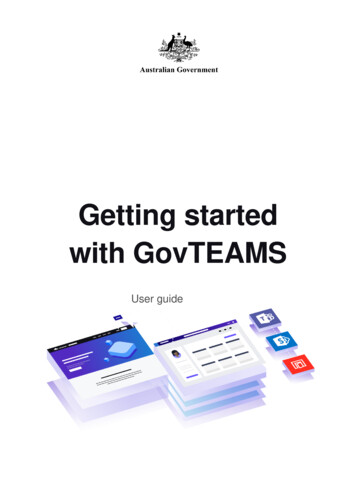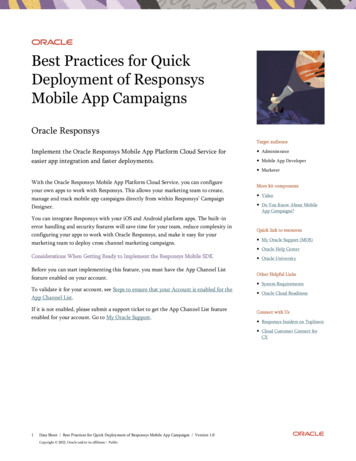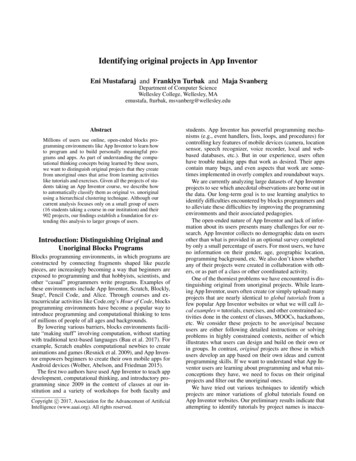
Transcription
Identifying original projects in App InventorEni Mustafaraj and Franklyn Turbak and Maja SvanbergDepartment of Computer ScienceWellesley College, Wellesley, MAemustafa, fturbak, msvanberg@wellesley.eduAbstractMillions of users use online, open-ended blocks programming environments like App Inventor to learn howto program and to build personally meaningful programs and apps. As part of understanding the computational thinking concepts being learned by these users,we want to distinguish original projects that they createfrom unoriginal ones that arise from learning activitieslike tutorials and exercises. Given all the projects of students taking an App Inventor course, we describe howto automatically classify them as original vs. unoriginalusing a hierarchical clustering technique. Although ourcurrent analysis focuses only on a small group of users(16 students taking a course in our institution) and their902 projects, our findings establish a foundation for extending this analysis to larger groups of users.Introduction: Distinguishing Original andUnoriginal Blocks ProgramsBlocks programming environments, in which programs areconstructed by connecting fragments shaped like puzzlepieces, are increasingly becoming a way that beginners areexposed to programming and that hobbyists, scientists, andother “casual” programmers write programs. Examples ofthese environments include App Inventor, Scratch, Blockly,Snap!, Pencil Code, and Alice. Through courses and extracurricular activities like Code.org’s Hour of Code, blocksprogramming environments have become a popular way tointroduce programming and computational thinking to tensof millions of people of all ages and backgrounds.By lowering various barriers, blocks environments facilitate “making stuff” involving computation, without startingwith traditional text-based languages (Bau et al. 2017). Forexample, Scratch enables computational newbies to createanimations and games (Resnick et al. 2009), and App Inventor empowers beginners to create their own mobile apps forAndroid devices (Wolber, Abelson, and Friedman 2015).The first two authors have used App Inventor to teach appdevelopment, computational thinking, and introductory programming since 2009 in the context of classes at our institution and a variety of workshops for both faculty andCopyright c 2017, Association for the Advancement of ArtificialIntelligence (www.aaai.org). All rights reserved.students. App Inventor has powerful programming mechanisms (e.g., event handlers, lists, loops, and procedures) forcontrolling key features of mobile devices (camera, locationsensor, speech recognizer, voice recorder, local and webbased databases, etc.). But in our experience, users oftenhave trouble making apps that work as desired. Their appscontain many bugs, and even aspects that work are sometimes implemented in overly complex and roundabout ways.We are currently analyzing large datasets of App Inventorprojects to see which anecdotal observations are borne out inthe data. Our long-term goal is to use learning analytics toidentify difficulties encountered by blocks programmers andto alleviate these difficulties by improving the programmingenvironments and their associated pedagogies.The open-ended nature of App Inventor and lack of information about its users presents many challenges for our research. App Inventor collects no demographic data on usersother than what is provided in an optional survey completedby only a small percentage of users. For most users, we haveno information on their gender, age, geographic location,programming background, etc. We also don’t know whetherany of their projects were created in collaboration with others, or as part of a class or other coordinated activity.One of the thorniest problems we have encountered is distinguishing original from unoriginal projects. While learning App Inventor, users often create (or simply upload) manyprojects that are nearly identical to global tutorials from afew popular App Inventor websites or what we will call local examples tutorials, exercises, and other constrained activities done in the context of classes, MOOCs, hackathons,etc. We consider these projects to be unoriginal becauseusers are either following detailed instructions or solvingproblems in highly constrained contexts, neither of whichillustrates what users can design and build on their own orin groups. In contrast, original projects are those in whichusers develop an app based on their own ideas and currentprogramming skills. If we want to understand what App Inventor users are learning about programming and what misconceptions they have, we need to focus on their originalprojects and filter out the unoriginal ones.We have tried out various techniques to identify whichprojects are minor variations of global tutorials found onApp Inventor websites. Our preliminary results indicate thatattempting to identify tutorials by project names is inaccu-
rate; instead, structural comparisons with known tutorialsbased on project content is needed.The problem of how to detect local examples is more vexing since they are, by definition, local to a class, and at thevery least require knowing which students are taking a classtogether. As described later, we have developed a way to automatically discover in our dataset collections of users whoappear to be groups of students taking the same class.In this paper, we investigate this research question: givena collection of all App Inventor projects from students ina class, can we automatically classify such projects as either being unoriginal (i.e., based on global tutorials or local examples) or original (i.e., projects that students created on their own or in small groups)?We studied this problem using the 902 projects created byall 16 students in a CS0 App Inventor course taught by thesecond author at our institution in Fall, 2015. We manuallylabeled the 902 projects as being global tutorials, local examples, or original projects. We then developed an algorithmthat (1) represents App Inventor projects as feature vectorsand (2) uses hierarchical clustering based on similarities between feature vectors to automatically classify projects asunoriginal or original. The classification determined by ouralgorithm matches our ground truth labels to a high degreeof accuracy, and the clusters found by the algorithm alignwell with particular global tutorials and local examples.Related WorkThe work most closely related to ours is the automated analysis of App Inventor projects by (Xie, Shabir, and Abelson 2015; Xie and Abelson 2016). They automatically extract project summaries including types of components andblocks from project datasets to deduce skills and conceptsusers are learning over time. In (Xie, Shabir, and Abelson2015), they filter out projects classified as tutorials, but thisis determined only by the names of the projects, not theircontents. This work inspired us to find more accurate waysto identify unoriginal projects.Classifying students or their programs is a topic that hasinterested the research community for years, although notwith the same goals as our current research. Recently, Piechet al. used clustering of snapshots from the same assignmentto build a model that captured the different stages a studentgoes through while learning to program (Piech et al. 2012).Their analysis used a fine-grained data collection processthat currently doesn’t exist in App Inventor, but might become a reality in a near future (Sherman and Martin 2015).App Inventor: An OverviewMIT App Inventor is a browser-based blocks programmingenvironment for creating mobile apps for Android devices.It is popular: over 4.5 million registered users have creatednearly 17 million app projects, and there are over 340 thousand active monthly users. It has a broader age distributionof users than Scratch, and the range of compelling mobileapps is so large that everyone can find classes of apps tobe passionate about. Some users are drawn to App Inventor by the desire to learn programming or the lure of en-trepreneurship (App Inventor apps can be sold in the GooglePlay Store). But many just want to make an app for themselves, their family and friends, or their community.One of the first apps created by many App Inventor usersis TalkToMe (Figure 1), the subject of the first two videotutorials for beginners at the MIT App Inventor website1 .This app has two behaviors: (1) when a button is pressed, itwill speak aloud whatever text has been entered into a textbox; and (2) when the the device is shaken, it will speak thephrase “Stop Shaking me!”The app is specified in two parts within an App Inventorbrowser window. In the Designer window (part of which isshown in Figure 1(a)), the user drags and drops the components of an app from a palette into the representation of thescreen. Components include visible user interface elements,such as (in this case): a TextBox1 component entering thetext to be spoken and a Button1 component that causesthe text to be spoken when pressed. Components can alsobe object-like entities that add functionality to the app, inthis case: (1) a TextToSpeech1 component that “speaks”a string; and (2) an AccelerometerSensor1 componentthat can detect when the device is being shaken.The behavior of an app is specified in the Blocks Editor (Figure 1(b)). In this window, the user drags blocksfrom a blocks palette organized by functionality into a2D workspace and connects them. Some blocks (such aswhen Button1.Click) are event handlers that are triggered by an event involving the component. Other blocksinclude methods that operate on a component (such ascall TextToSpeech1.Speak), component property getters (such as TextBox1.Text) and setters, and built-inblocks like the string block for “Stop Shaking me!”.The capabilities of App Inventor go far beyond this simple example. For example, App Inventor apps can take anddisplay pictures and videos, record and play sounds, sendand receive text messages, make phone calls, scan barcodes,use GPS location data, and access, store, and process information saved persistently on the device or on the web.App Inventor project source code files are automaticallysaved in the cloud, but can be exported as .aia files. Eachof these is a zipped collection of files that includes a projectproperty file, media files used by the app, and, for eachscreen in the app, a JSON representation of its componentsand an XML representation of its blocks.Data and LabelingOur project dataset is 902 App Inventor .aia project sourcefiles created by all 16 students taking the second author’sWellesley course CS117 Inventing Mobile Apps in Fall2015. These files, provided to us by the MIT App Inventor team (with consent of the students) include additional timestamp information indicating (1) when the projectwas created and (2) when it was last modified. During thecourse students worked in pairs on various pair programming projects, and sometimes created new gmail accountsfor this work; unfortunately, we do not not have access tothe projects created in these other accounts. On average, the1http:appinventor.mit.edu
(a) Designer(b) Blocks EditorFigure 1: App Inventor TalkToMe tutorial appstudents created 56.4 projects (min 41, max 72, std 8.2),within the time period August 31 to December 23, 2015.Our goal was to classify the student projects as being unoriginal (closely related to global tutorials or local examples)or original (all other projects, including nontrivial extensionsto global tutorials or local examples).We began by collecting a set of 80 global tutorial appsfrom pedagogical websites for App Inventor. This includesvideo and written tutorials from appinventor.mit.eduand appinventor.org, including a set of 14 so-calledMaker Cards from appinventor.mit.edu that were distributed to students in the course. For each tutorial, wedownloaded or created an App Inventor project file. Insome cases, where a tutorial had multiple parts or suggested extensions, we created a separate project file foreach such part/extension. For example, the TalkToMe tutorial has two videos, and the second video has two extensions to the app created in the first video, so we namedthese projects TalkToMePart1, TalkToMePart2a, andTalkToMePart2b.We also collected projects for all the tutorials, exercises,and example App Inventor programs that were presented inthe CS117 class. These are the local example apps; therewere 46 of them.Since the second author was familiar with all course materials and student work, he manually examined all 902projects, comparing them to the global tutorial and localexample apps. Each student project that closely matched aglobal tutorial or local example was labeled GLOBAL or LO CAL along with which tutorial/example project it matched.All 46 local tutorials appeared in the student dataset, butonly 40 of the 80 global tutorials appeared. In some cases, astudent project was deemed to be a nontrivial extension to atutorial or example, and was labeled BEYOND a particular tutorial or example. A few (26) of the projects contained zeroblocks (they only had the layout of the app, not its behavior); these were labeled EMPTY and removed from furtherconsideration.Most remaining projects were related to one of five creative projects students were assigned. These increased incomplexity from the first assignment, in which students builta very simple app using a few randomly dealt components,to the open-ended final assignment, in which students designed and built from scratch an app of their choosing thathad to incorporate a web database. These projects were labeled COURSE PROJECT n, with n in the range 1 to 5.Finally, the small number of remaining projects were labeled as TESTING projects, because they tended to test certain components, often ones not covered in class.In terms of originality, we consider projects labeledGLOBAL or LOCAL to be UNORIGINAL and those labeledCLASS PROJECT , TESTING , or BEYOND to be ORIGINAL .Of the 876 nonempty projects in the dataset, only 280 (32%)were labeled as ORIGINAL; the remaining 596 (68%) wereUNORIGINAL . The fact that a large majority of projects inthe dataset were UNORIGINAL underscores the need to filter them out when analyzing student work for understanding,misconceptions, etc.Feature Representation and DistanceWe developed a Python program to summarize each .aiasource file as a JSON file containing, for each screen in theapp, the types and frequencies of the components and blocksused in the screen. As shown in Figure 1(b), the behaviorof an app is specified by blocks. For blocks that operateon a component (e.g., event handlers, methods, and component property getters and setters), we only distinguish blocksby the type of the component and not the particular component name. For example, an app with a .Click handlerfor a StartButton and StopButton is considered to havetwo occurrences of the Button.Click block. But the property getter that extracts the current string contents of a label(Label.Text) is considered different from the one that returns the string in a text box (TextBox.Text). Blocks thatspecify values like numbers or strings are distinguished onlyby their types and not their values. While there are morethan one thousand distinct block types in App Inventor, ourdataset of 902 student projects, 40 global tutorials, and 46local examples uses only 347 different block types.In a program, the order and nested organization of blocks
(a)(b)Figure 2: Distribution of distances using 1-NN classification of student projects relative to (a) both global tutorials and localexamples and (b) only global tutorials. Without knowledge of local examples, many unoriginal projects would appear to beoriginal based just on their 1-NN distance.matters, just like the order of words gives meaning to adocument. However, relying on the successful bag-of-wordsmodel that discards order to focus on presence and frequency of words in a document, we experimented with a unigram model in which all block types are independent. Ourexperiments with various combinations of features for determining similarity between App Inventor projects showedthat representing a project as a vector of the 347 block typefrequencies (disregarding components) was adequate for ourneeds. Because of this decision, two projects with the sameblocks that differ only in details of their user interface areconsidered the same. Intuitively, the originality of a projectis captured by the kind and number of blocks that are notcommon in unoriginal projects.Our sample of 988 projects (902 from students, 40 globaltutorials, and 46 local examples) has an average of 65.9 totalblocks per project (median 49, std 68.2, min 0, max 557).For unique block types, the statistics are: 20.3 unique blocksin average (median 19, std 13.2, min 0, max 71). So, onaverage, 20 of the 347 slots in a project feature vector arenon-zero.To determine distance between project feature vectors, weexperimented with various metrics, including Euclidean andJaccard. Jaccard similarity determines the ratio of the intersection of features divided by the union of features. Jaccard distance is 1 minus the similarity. So entities that arethe same have a Jaccard distance of 0, while those withnothing in common have Jaccard distance of 1. We foundthat the Jaccard distance metric worked well on projects,and it worked best when the block type feature vectorused frequency counts rather than binary values (wherea 1 indicates at least one block of a given type). However, the jaccard option in the Python scipy libraryspatial.distance.pdist did not correctly handle frequency counts, so we had to supply a function for correctlycomputing it.In our following presentation, it is assumed that projectsare represented as feature vectors based on block types withcounts, and distances are calculated via the Jaccard metric.Classification, Clustering, or Both?Our first approach for distinguishing between original andunoriginal projects was to apply the k-NN classification algorithm with k 1. Given that the set of tutorials is known,we can calculate the distance of every project to these knowntutorials and then assign the label of the closest tutorial toa project. The problem with this approach is that by having only one labeled example per class, it’s very difficult toestablish the hyperspace boundaries between the differentclasses (with each tutorial being a class on its own). It alsodepends on the set of known tutorials.For most App Inventor users, we know only the globaltutorials. For our particular experiment, we also happen toknow the 46 example projects that were local to the class.This knowledge makes a huge difference. For our datasetwith 86 known tutorials (40 global and 46 local), the distributions of distances for original and unoriginal projects tothe closet tutorials are mostly distinct, as shown by the histogram in Figure 2(a). However, if we repeat the same 1-NNclassification, but only using the set of the known global tutorials, the two classes of original and unoriginal projects areall in the same space, making it hard to distinguish betweenthe two categories (Figure 2(b)).When classifying student projects by distance betweenknown tutorials, we miss an important source of information: the similarity of projects to other projects. Even if wedon’t have a priori knowledge of the local examples usedin class, when many projects belonging to different studentsare close together, this strongly suggests that they are unoriginal near-copies of global tutorials or local examples.This can be revealed through clustering. Consider the dendrogram in Figure 3 generated by applying hierarchical clustering to a subset of (1) 58 projects chosen because theirnames resembled the names of some global tutorials and(2) 7 of the actual tutorials. In this case, hierarchical clus-
Figure 3: Annotated dendrogram showing the clustering of58 student projects and 7 known tutorial projects.Figure 4: Annotated dendrogram showing the clustering of77 student projects labeled as ORIGINAL.tering does a remarkable job of clustering projects that wehad labeled in the same way. We have annotated the diagramwith clusters A through I for expository purposes. Each suchannotated cluster corresponds to a labeling for a particularglobal tutorial or local example. For example, cluster I corresponds to the Maker Card Stopwatch tutorial, and even includes the TalkToMe project of user 10363, which is poorlynamed and is in fact really a stopwatch project. Cluster Hcorresponds to the Maker Card Counter tutorial, which hasa subset of blocks in the Stopwatch tutorial. Cluster C corresponds to the tutorial for a much more accurate local stopwatch tutorial presented to students when they were workingon their final projects. Cluster E corresponds to the starterand solution files for a local GPS path tracking tutorial presented in class. Clusters F and G are, respectively, many versions of the global DigitalDoodle and TalkToMe tutorials. The two leftmost projects in cluster F were labeled asnontrivial extensions to DigitalDoodle, so it makes sensethat they join the cluster as singletons high in the tree.Each of the non-singleton annotated clusters containsprojects from several students in the class, making the clusters reveal their nature as a learning activity as opposed toan original individual or pair project.From observing the clustering of student projects labeledas ORIGINAL (see dendrogram in Figure 4), we can gainmore intuition about how a hybrid process of classificationand clustering could work. We have annotated the dendrogram with lettered clusters for the sake of exposition. Clusters A, B, and K correspond to different versions of the sameoriginal game project done by a pair of students. Clusters C,E, F, G, H, I, J, and L correspond to different individual andpair projects. Cluster F has 13 projects created by students05278 and 39972, but there is also one copy of their projectin the folder of student 43502 that apparently was sharedwith this other student. The student partners have a balancednumber of iterative versions of the projects (7 and 6). Meanwhile, Cluster H has 14 projects created mostly by the twostudents 11991 and 32045, with one interjection by student30045. Differently from Cluster F, one of the students in thiscluster has generated more versions (9 versus 4). These examples suggest that clusters of many similar projects createdmostly by a small number of users can be automatically classified as original projects, because they indicate sequentialprogress on a project. Since App Inventor doesn’t have version control, users save versions manually, which indicateshow a project progressed over time.Cluster D is interesting because it includes the work offour students from the third original project in the course,which was an individual project. These students did notwork together, but their projects are lumped together because this particular original project was much more constrained than the others: students were required to implement an app that recorded voice memos and had an interface for saving, displaying, playing, and deleting the voicememos. While the apps had different interfaces and numbersof screens, they ended up using many similar blocks and sowere clustered together by our Jaccard distance metric thatemphasizes block similarity. Because cluster D contains theprojects of many students, our approach would incorrectlyclassify it as an unoriginal activity as opposed to a collection of similar original individual projects that it really is.A Hybrid Approach: Classification throughClusteringA project is unoriginal if it is very similar to one of the existing global or local tutorials. However, since often not allthese tutorials are known a priori, a project will be deemedunoriginal if it is similar to projects from a large numberof different users. Thus, once a relatively tight cluster ofprojects from different users has been created, all of theprojects can be classified as UNORIGINAL.A project is original if it is not similar to any cluster ofknown unoriginal projects. Such a project might often occur within a cluster of other original projects. Thus, if wediscover a cluster of many projects contributed by a smallnumber of users, we can classify all of them as ORIGINAL.What makes this classification interesting and different
Ongoing and Future WorkFigure 5: The accuracy for the ORIGINAL class is highest for small Jaccard distances and declines as this distance increases, because ORIGINAL projects get mergedinto clusters where the majority is composed of UNORIG INAL projects.from other classification problems is the fact that it relieson meta-information outside the projects: the users, numberof users in a cluster, and similarity to other projects.We implemented this hybrid two-step clustering and classification as follows: we performed hierarchical clustering using the generalized Jaccard distance metric and theaverage linkage method. From our visual inspection ofseveral dendrograms depicting subsets of the data, we hadnoticed that unoriginal projects tend to cluster together atsmall distance values, while original projects were mergedonly at large distances. We decided that all singleton projectswith a distance higher than 0.8 from all other projects areORIGINAL . Then, flattening the dendrogram at different cutoff distances between 0.3 and 0.8 we applied (appropriately)the classifications UNORIGINAL or ORIGINAL to clustersbased on the rules described above.Results of ClassificationGiven that we know the real labels, we can estimate the accuracy of such an automatic classification at different distance levels. Our labeled dataset is unbalanced: 280 original projects and 596 unoriginal projects. Given that we caremore about correctly predicting the ORIGINAL class, wewill calculate the accuracy for each label separately. The results are represented by the two lines in Figure 5. At thedistance 0.4, the two accuracies are both at 89%. Furtherincreasing the distance means that some singleton, originalprojects start getting merged into clusters where the majority is UNORIGINAL. This result indicates that by cutting offthe hierarchical clustering at distance 0.4, we get a high accuracy of labeling for both classes (89%). In future work,we will consider different ways of performing this processthat takes into account other metadata about the projects, forexample, their timestamps.This work is based on data from students in a known class.Is it possible for us to automatically discover other classesof students in our App Inventor datasets? In other work (inprogress), we are exploring ways to discover which App Inventor users are likely to be students taking a class togetherusing creation timestamps for their projects. This is basedon the observation that two students in the same class willbe more likely to create projects at the same time (as part ofclassroom activities) than two arbitrarily chosen users. Clustering users based on this idea, we have been able to discovercandidate classes of students, including the exact membersof Wellesley’s Fall 2015 CS117 App Inventor course.In other work, we are also: identifying projects “in thewild” as being minor variations of particular global tutorials; determining which user projects appear to be a sequenceof versions of a single original app project; and investigating the components, blocks, and programming patterns thatusers typically employ in their original projects.One application of this line of work would be creating ateacher dashboard for App Inventor instructors. Automatically classifying all student projects as global tutorials, local examples, and original projects would help teachers better understand the participation and progress of their students. And visualizing the concepts and misconceptions inthe original projects would provide detailed information forhighlighting areas in which students might need guidance.AcknowledgmentsThis work was supported by Wellesley College FacultyGrants and by NSF grant DUE-1226216.ReferencesBau, D.; Gray, J.; Kelleher, C.; Sheldon, J. S.; and Turbak, F.2017. Learnable programming: Blocks and beyond. Communications of the ACM. To appear.Piech, C.; Sahami, M.; Koller, D.; Cooper, S.; and Blikstein,P. 2012. Modeling how students learn to program. In 43rdACM Technical Symposium on Computer Science Education, 153–160. ACM.Resnick, M.; Maloney, J.; Monroy-Hernández, A.; Rusk, N.;Eastmond, E.; Brennan, K.; Millner, A.; Rosenbaum, E.; Silver, J.; and Silverman, B. 2009. Scratch: programming forall. Communications of the ACM 52(11):60–67.Sherman, M., and Martin, F. 2015. Learning analytics forthe assessment of interaction with App Inventor. In IEEEBlocks and Beyond Workshop, 13–14.Wolber, D.; Abelson, H.; and Friedman, M. 2015. Democratizing computing with App Inventor. GetMobile: MobileComputing and Communications 18(4):53–58.Xie, B., and Abelson, H. 2016. Skill progression in MITApp Inventor. In IEEE Symposium on Visual Languages andHuman-Centric Computing, 213–217.Xie, B.; Shabir, I.; and Abelson, H. 2015. Measuring theusability and capability of App Inventor to create mobile applications. In 3rd International Workshop on Programmingfor Mobile and Touch, 1–8.
from pedagogical websites for App Inventor. This includes video and written tutorials from appinventor.mit.edu and appinventor.org, including a set of 14 so-called Maker Cards from appinventor.mit.edu that were dis-tributed to students in the course. For each tutorial, we downloaded or created an App Inventor project file. In

